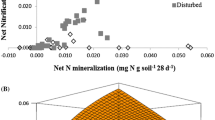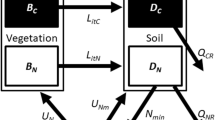Abstract
Disturbances affect almost all terrestrial ecosystems, but it has been difficult to identify general principles regarding these influences. To improve our understanding of the long-term consequences of disturbance on terrestrial ecosystems, we present a conceptual framework that analyzes disturbances by their biogeochemical impacts. We posit that the ratio of soil and plant nutrient stocks in mature ecosystems represents a characteristic site property. Focusing on nitrogen (N), we hypothesize that this partitioning ratio (soil N: plant N) will undergo a predictable trajectory after disturbance. We investigate the nature of this partitioning ratio with three approaches: (1) nutrient stock data from forested ecosystems in North America, (2) a process-based ecosystem model, and (3) conceptual shifts in site nutrient availability with altered disturbance frequency. Partitioning ratios could be applied to a variety of ecosystems and successional states, allowing for improved temporal scaling of disturbance events. The generally short-term empirical evidence for recovery trajectories of nutrient stocks and partitioning ratios suggests two areas for future research. First, we need to recognize and quantify how disturbance effects can be accreting or depleting, depending on whether their net effect is to increase or decrease ecosystem nutrient stocks. Second, we need to test how altered disturbance frequencies from the present state may be constructive or destructive in their effects on biogeochemical cycling and nutrient availability. Long-term studies, with repeated sampling of soils and vegetation, will be essential in further developing this framework of biogeochemical response to disturbance.




Similar content being viewed by others
References
Antoine ME. 2004. An ecophysiological approach to quantifying nitrogen fixation by Lobaria oregana. Bryologist 107:82–7.
Appling AP. 2012. Connectivity drives function: carbon and nitrogen dynamics in a floodplain-aquifer ecosystem. Durham: Duke University.
Ayris PM, Delmelle P. 2012. The immediate environmental effects of tephra emission. Bull Volcanol 74:1905–36.
Baker WL. 2009. Fire ecology in rocky mountain landscapes. Washington DC: Island Press.
Belyea LR, Baird AJ. 2006. Beyond ‘the limits to peat bog growth’: cross-scale feedback in peatland development. Ecol Monogr 76:299–322.
Block CE, Knoepp JD, Elliott KJ, Fraterrigo JM. 2012. Impacts of hemlock loss on nitrogen retention vary with soil nitrogen availability in the southern Appalachian mountains. Ecosystems 15:1108–20.
Bond WJ. 2008. What limits trees in C-4 grasslands and savannas? Annu Rev Ecol Evol Syst 39:641–59.
Bormann FH, Likens GE. 1979. Pattern and process in a forested ecosystem. New York: Springer.
Clemmensen KE, Bahr A, Ovaskainen O, Dahlberg A, Ekblad A, Wallander H, Stenlid J, Finlay RD, Wardle DA, Lindahl BD. 2013. Roots and associated fungi drive long-term carbon sequestration in boreal forest. Science 339:1615–18.
de Dantas VL, Batalha MA, Pausas JG. 2013. Fire drives functional thresholds on the savanna–forest transition. Ecology 94:2454–63.
DeAngelis DL. 1980. Energy flow, nutrient cycling, and ecosystem resilience. Ecology 61:764–71.
Davidson EA, de Carvalho CJR, Figueira AM, Ishida FY, Ometto JP, Nardoto GB, Saba RT, Hayashi SN, Leal EC, Vieira IC, Martinelli L. 2007. Recuperation of nitrogen cycling in Amazonian forests following agricultural abandonment. Nature 447:995–8.
Dennison PE, Brewer SC, Arnold JD, Moritz MA. 2014. Large wildfire trends in the western United States, 1984-2011. Geophys Res Lett 41:2928–33.
Donnelly JP, Woodruff JD. 2007. Intense hurricane activity over the past 5,000 years controlled by El Nino and the West African monsoon. Nature 447:465–8.
Egnell G. 2011. Is the productivity decline in Norway spruce following whole-tree harvesting in the final felling in boreal Sweden permanent or temporary? Forest Ecol Manag 261:148–53.
Foster D, Swanson F, Aber J, Burke I, Brokaw N, Tilman D, Knapp A. 2003. The importance of land-use legacies to ecology and conservation. Bioscience 53:77–88.
Gorham E, Vitousek PM, Reiners WA. 1979. The regulation of chemical budgets over the course of terrestrial ecosystem succession. Annu Rev Ecol Syst 10:53–84.
Gough C, Vogel C, Harrold K, George K, Curtis P. 2007. The legacy of harvest and fire on ecosystem carbon storage in a north temperate forest. Global Change Biol 13:1935–49.
Harmon ME. 1992. Long-term experiments on log decomposition at the H.J. Andrews Experimental Forest. PNW-GTR-280, U.S. Department of Agriculture, Forest Service, Pacific Northwest Research Station, Portland, Oregon.
Haeussler S. 2011. Rethinking biogeoclimatic ecosystem classification for a changing world. Environ Rev 19:254–77.
Hazlett PW, Curry JM, Weldon TP. 2011. Assessing decadal change in mineral soil cation chemistry at the Turkey Lakes watershed. Soil Sci Soc Am J 75:287–305.
Hicke JA, Allen CD, Desai AR, Dietze MC, Hall RJ, Hogg EH, Kashian DM, Moore D, Raffa KF, Sturrock RN, Vogelmann J. 2012. Effects of biotic disturbances on forest carbon cycling in the United States and Canada. Global Change Biol 18:7–34.
Higuera PE, Briles CE, Whitlock C. 2014. Fire-regime complacency and sensitivity to centennial-through millennial-scale climate change in Rocky Mountain subalpine forests, Colorado, USA. J Ecol 102:1429–41.
Himes AJ, Turnblom EC, Harrison RB, Littke KM, Devine WD, Zabowski D, Briggs DG. 2014. Predicting risk of long-term nitrogen depletion under whole-tree harvesting in the Coastal Pacific Northwest. Forest Sci 60:382–90.
Hobbie JE, Kling GW. 2014. Alaska’s changing arctic: ecological consequences for tundra, streams, and lakes. Oxford: Oxford University Press.
Johnson DW, Turner J. 2014. Nitrogen budgets of forest ecosystems: a review. Forest Ecol Manag 318:370–9.
Jordan CF. 1985. Nutrient cycling in tropical forest ecosystems. Chichester: Wiley.
Jordan CF, Cline JR, Sasscer DS. 1972. Relative stability of mineral cycles in forest ecosystems. Am Nat 106:237–53.
Mack MC, Bret-Harte MS, Hollingsworth TN, Jandt RR, Schuur EAG, Shaver GR, Verbyla DL. 2011. Carbon loss from an unprecedented Arctic tundra wildfire. Nature 475:489–92.
Marlon JR, Bartlein PJ, Gavin DG, Long CJ, Anderson RS, Briles CE, Brown KJ, Colombaroli D, Hallett DJ, Power MJ, Scharf EA, Walsh MK. 2012. Long-term perspective on wildfires in the western USA. Proc Natl Acad Sci USA 109:E535–43.
Paré D, Rochon P, Brais S. 2002. Assessing the geochemical balance of managed boreal forests. Ecol Indic 1:293–311.
Pearce AR, Rastetter EB, Kwiatkowski BL, Bowden WB, Mack MC, Jiang Y. 2015. Recovery of Arctic tundra from thermal erosion disturbance is constrained by nutrient accumulation: a modeling analysis. Ecol Appl, in press. http://dx.doi.org/10.1890/14-1323.1
Pellegrini AFA, Hoffmann WA, Franco AC. 2014. Carbon accumulation and nitrogen pool recovery during transitions from savanna to forest in central Brazil. Ecology 95:342–52.
Perakis SS, Sinkhorn ER, Compton JE. 2011. Delta(15)N constraints on long-term nitrogen balances in temperate forests. Oecologia 167:793–807.
Peters DPC, Lugo AE, Chapin III FS, Pickett STA, Duniway M, Rocha AV, Swanson FJ, Laney C, Jones J. 2011. Cross-system comparisons elucidate disturbance complexities and generalities. Ecosphere 2:art81.
Pickett STA, White PS. 1985. The ecology of natural disturbance and patch dynamics. NY: Academic Press.
Ponder F Jr, Fleming RL, Berch S, Busse MD, Elioff JD, Hazlett PW, Kabzems RD, Kranabetter JM, Morris DM, Page-Dumroese D, Palik BJ, Powers RF, Sanchez FG, Scott DA, Stagg RH, Stone DM, Young DH, Zhang J, Ludovici KH, McKenney DW, Mossa DS, Sanborn PT, Voldseth RA. 2012. Effects of organic matter removal, soil compaction and vegetation control on 10th year biomass and foliar nutrition: LTSP continent-wide comparisons. Forest Ecol Manag 278:35–54.
Powers RF. 2006. Long-Term Soil Productivity: genesis of the concept and principles behind the program. Can J Forest Res 36:519–28.
Prescott CE, Maynard DG, Laiho R. 2000. Humus in northern forests: friend or foe? Forest Ecol Manag 133:23–36.
Raffa KF, Aukema BH, Bentz BJ, Carroll AL, Hicke JA, Turner MG, Romme WH. 2008. Cross-scale drivers of natural disturbances prone to anthropogenic amplification: the dynamics of bark beetle eruptions. Bioscience 58:501–17.
Rastetter EB, Yanai RD, Thomas RQ, Vadeboncoeur MA, Fahey TJ, Fisk MC, Kwiatkowski BL, Hamburg SP. 2013. Recovery from disturbance requires resynchronization of ecosystem nutrient cycles. Ecol Appl 23:621–42.
Reiners WA. 1983. Disturbance and basic properties of ecosystem energetics. In: Mooney HM, Gordon M, Eds. Disturbance and ecosystems: components of response. Ecological Studies, vol 44, New York: Springer, pp 83–98.
Risser PG, Birney EC, Blocker HD, May SW, Parton WJ, Wiens JA. 1981. The true prairie ecosystem. Stroudsburg: Academic Press.
Romme WH, Boyce MS, Gresswell R, Merrill EH, Minshall GW, Whitlock C, Turner MG. 2011. Twenty years after the 1988 Yellowstone fires: lessons about disturbance and ecosystems. Ecosystems 14:1196–215.
Running SW. 2008. Ecosystem disturbance, carbon, and climate. Science 321:652–3.
Saint-André L, Laclau J-P, Deleporte P, Gava JL, Gonçalves JL, Mendham D, Nzila JD, Smith C, duToit B, Xu DP, Sankaren KV, Marien JN, Nouvellon Y, Bouillet J-P, Ranger J. 2008. Slash and litter management effects on Eucalyptus productivity: a synthesis using a growth and yield modelling approach. Nambiar EKS, editor. Site management and productivity in tropical plantation forests: workshop proceedings, 22–26 November 2004, Piracicaba, Brazil and 6–9 November, Bogor, Indonesia. Center for International Forestry Research, Bogor, Indonesia. pp 173–189.
Scott GAJ. 1978. Grassland development in the Gran Pajonal of eastern Peru. Honolulu: University of Hawaii.
Simard M, Lecomte N, Bergeron Y, Bernier PY, Paré D. 2007. Forest productivity decline caused by successional paludification of boreal soils. Ecol Appl 17:1619–37.
Smithwick EAH, Kashian DM, Ryan MG, Turner MG. 2009. Long-term nitrogen storage and soil nitrogen availability in post-fire lodgepole pine ecosystems. Ecosystems 12:792–806.
Staver AC, Archibald S, Levin SA. 2011. The global extent and determinants of savanna and forest as alternative biome states. Science 334:230–2.
Thiffault E, Hannam KD, Paré D, Titus BD, Hazlett PW, Maynard DG, Brais S. 2011. Effects of forest biomass harvesting on soil productivity in boreal and temperate forests—a review. Environ Rev 19:278–309.
Turner MG. 2010. Disturbance and landscape dynamics in a changing world. Ecology 91:2833–49.
Vitousek PM, Reiners WA. 1975. Ecosystem succession and nutrient retention: a hypothesis. Bioscience 25:376–81.
Walker LR, Wardle DA. 2014. Plant succession as an integrator of contrasting ecological time scales. Trends Ecol Evol 29:504–10.
West NE, Skujins JJ. 1978. Nitrogen in desert ecosystems. Stroudsburg: Academic Press.
Zackrisson O, DeLuca TH, Nilsson M-C, Sellstedt A, Berglund LM. 2004. Nitrogen fixation increases with successional age in boreal forests. Ecology 85:3327–34.
Acknowledgements
We thank members of the Novus Research Coordination Network for helpful discussion. We also thank the Long-term Soil Productivity network for contributions of site N data, including Andy Scott, Dave Morris, Paul Hazlett, Rob Fleming, Deb Page-Dumerose, Felix Ponder, Mary-Beth Adams, Richard Kabzems, Bill Chapman, and Graeme Hope. This material is based upon work supported by the National Science Foundation under Grant No. DEB-1145815 and 0949420. Bill Reiners and an anonymous reviewer provided helpful comments on an earlier version of the manuscript. Any use of trade names is for descriptive purposes only and does not imply endorsement by the US Government.
Author information
Authors and Affiliations
Corresponding author
Additional information
Author Contributions
The study was conceived and designed during a Novus-RCN workshop with the full participation of all the authors; JMK, KKM, and JLM analyzed data; SKE, JMF, PEH, EBR contributed new models; JMK and KKM wrote manuscript with contributions from all the co-authors.
Rights and permissions
About this article
Cite this article
Kranabetter, J.M., McLauchlan, K.K., Enders, S.K. et al. A Framework to Assess Biogeochemical Response to Ecosystem Disturbance Using Nutrient Partitioning Ratios. Ecosystems 19, 387–395 (2016). https://doi.org/10.1007/s10021-015-9934-1
Received:
Accepted:
Published:
Issue Date:
DOI: https://doi.org/10.1007/s10021-015-9934-1




